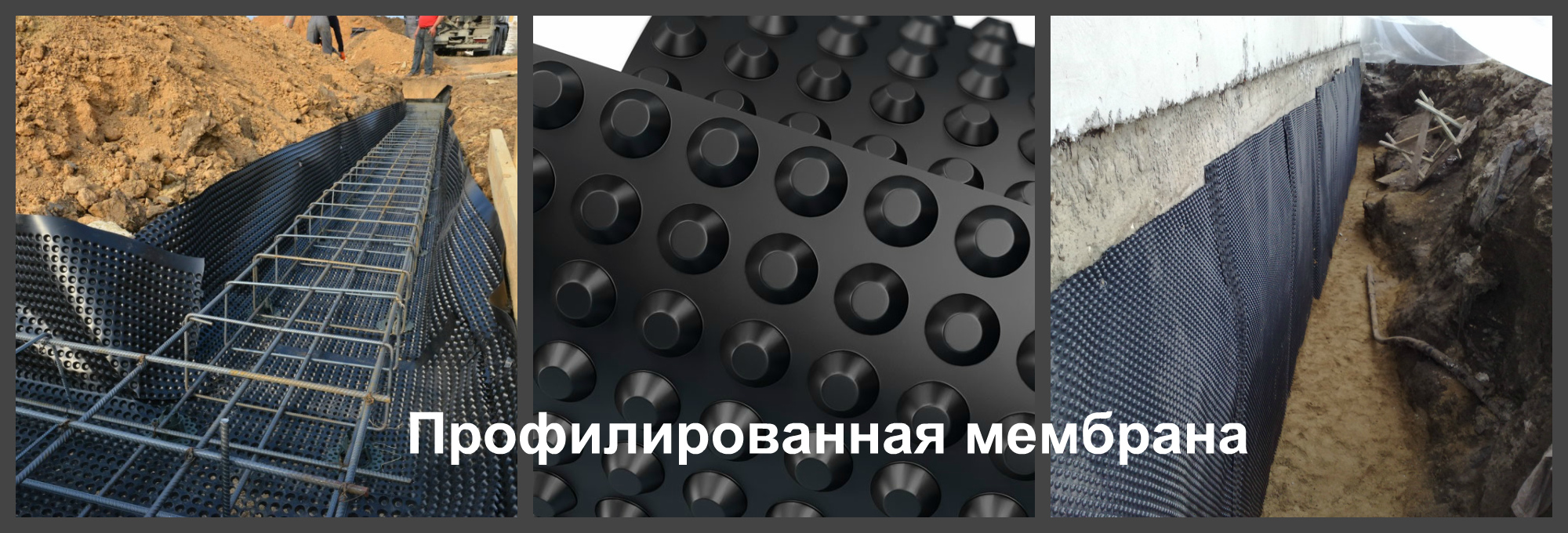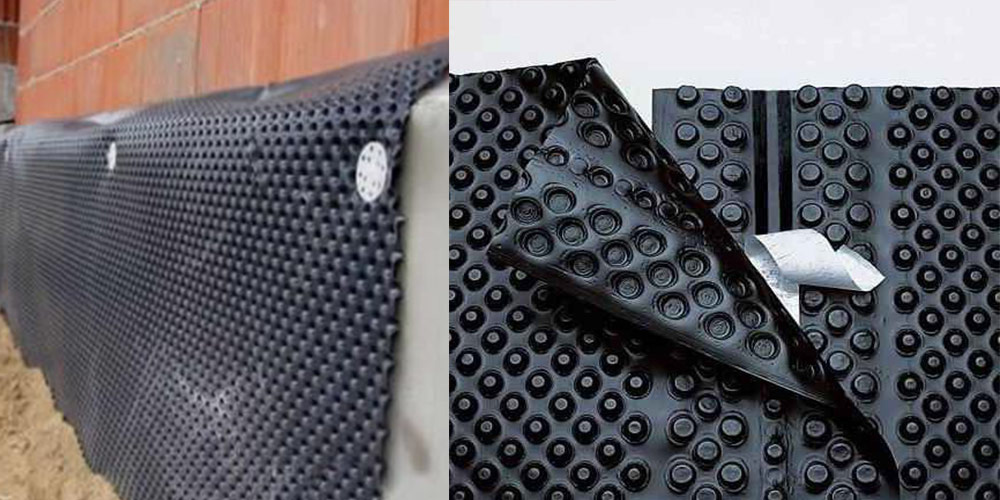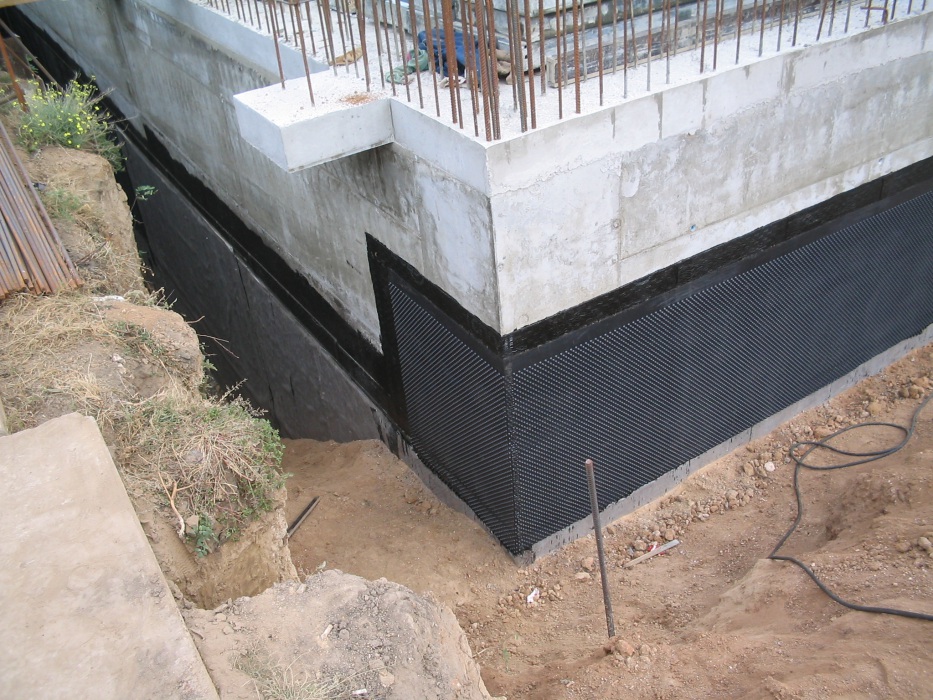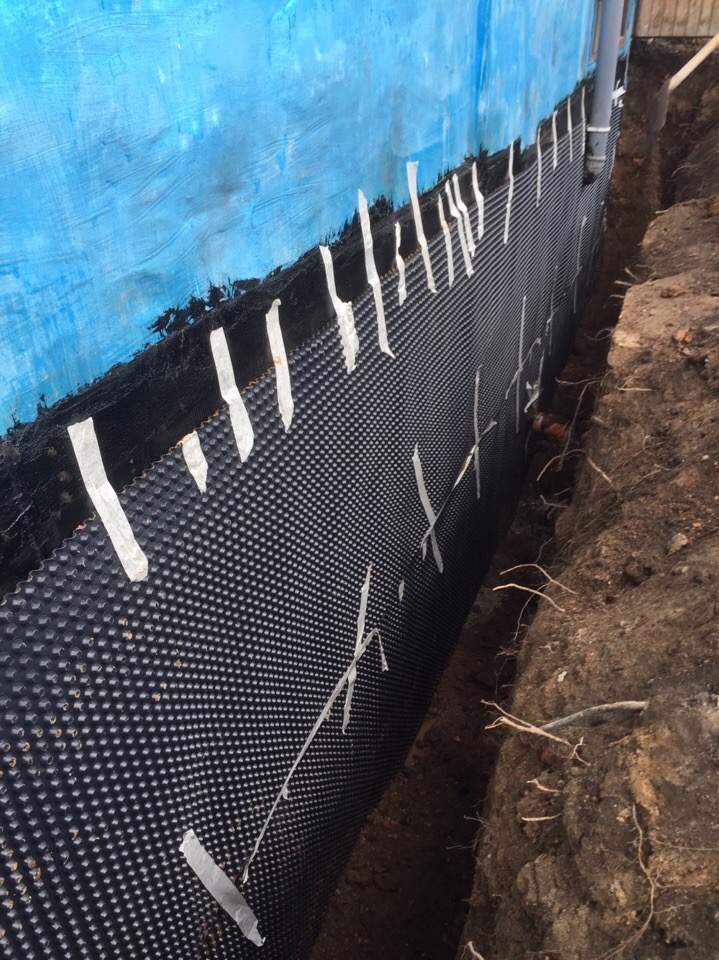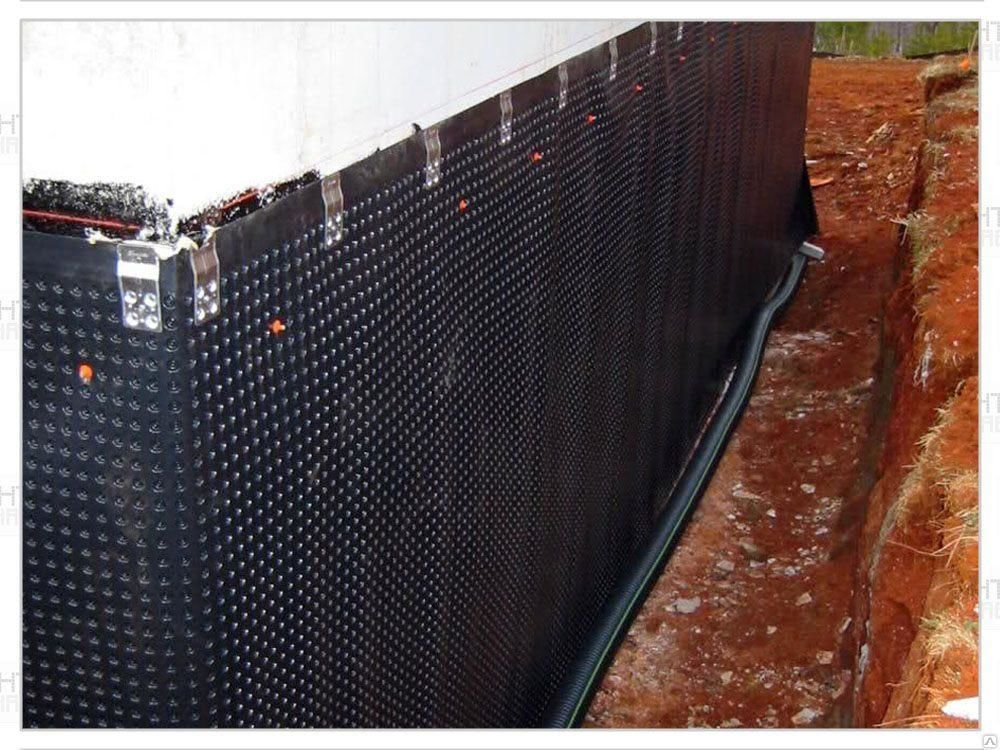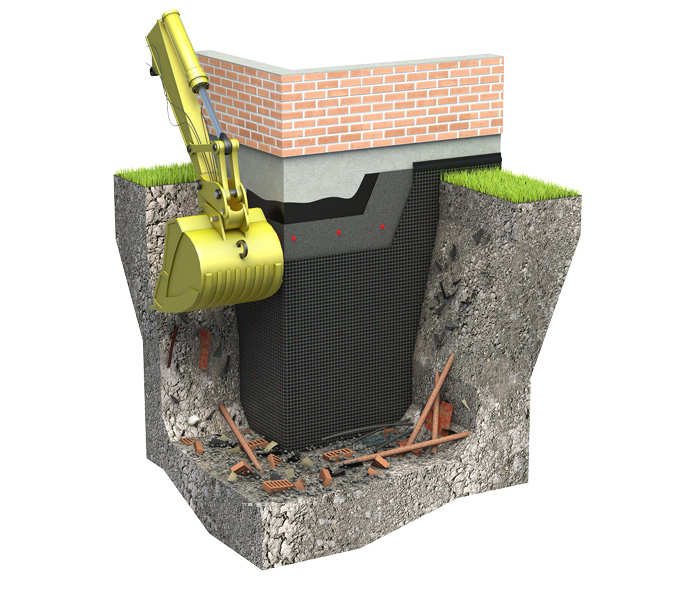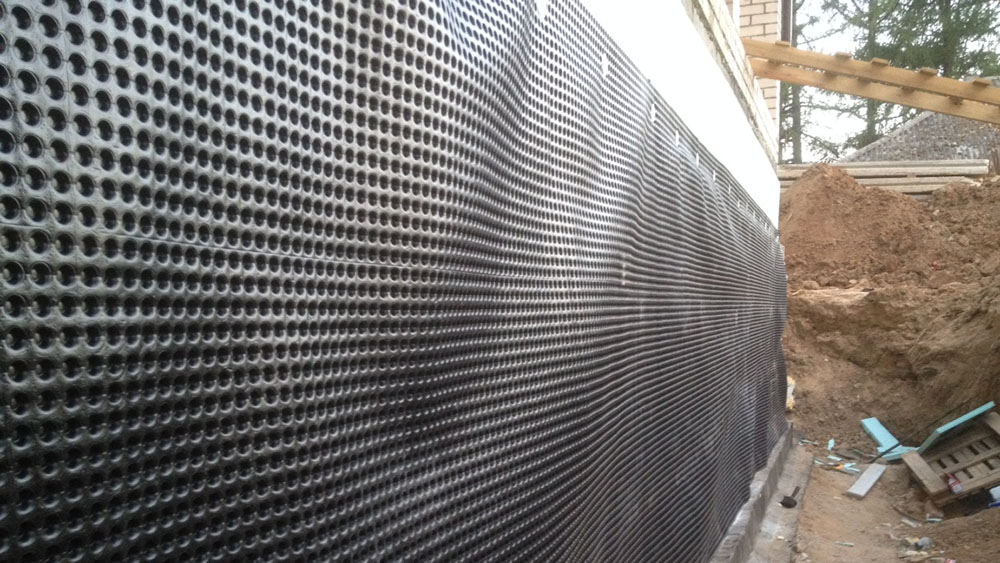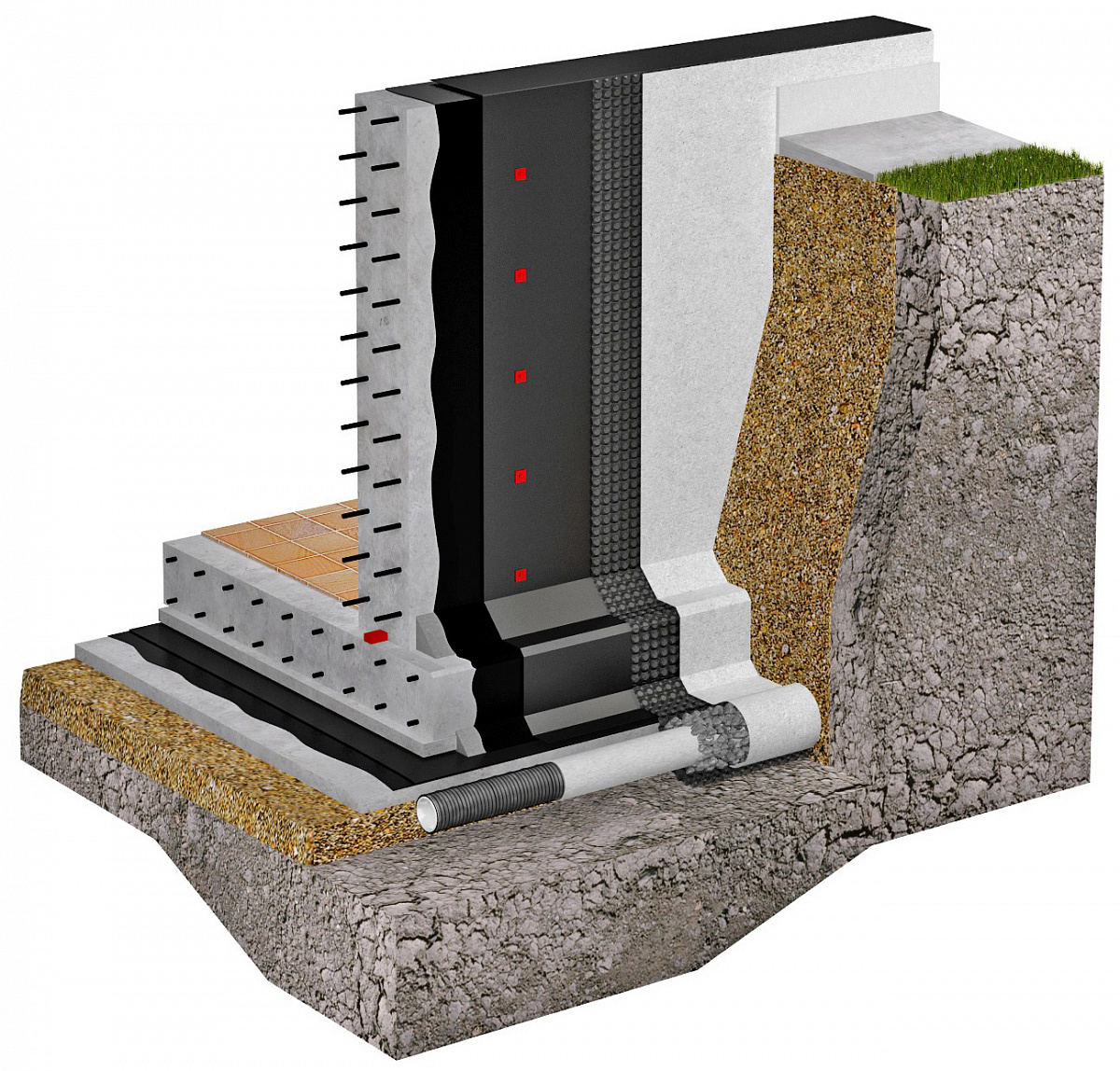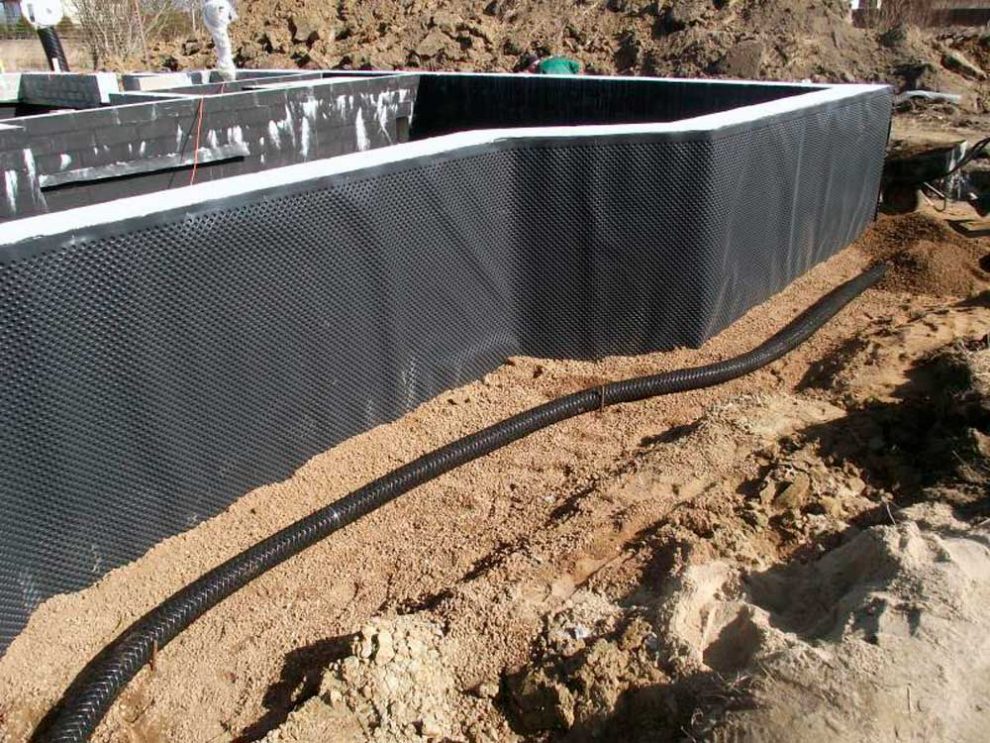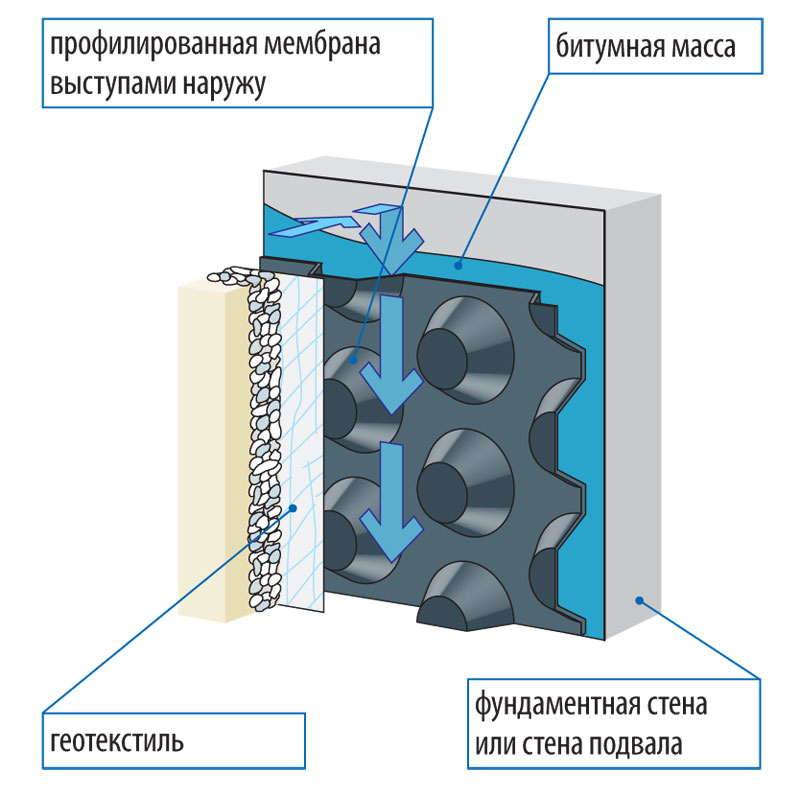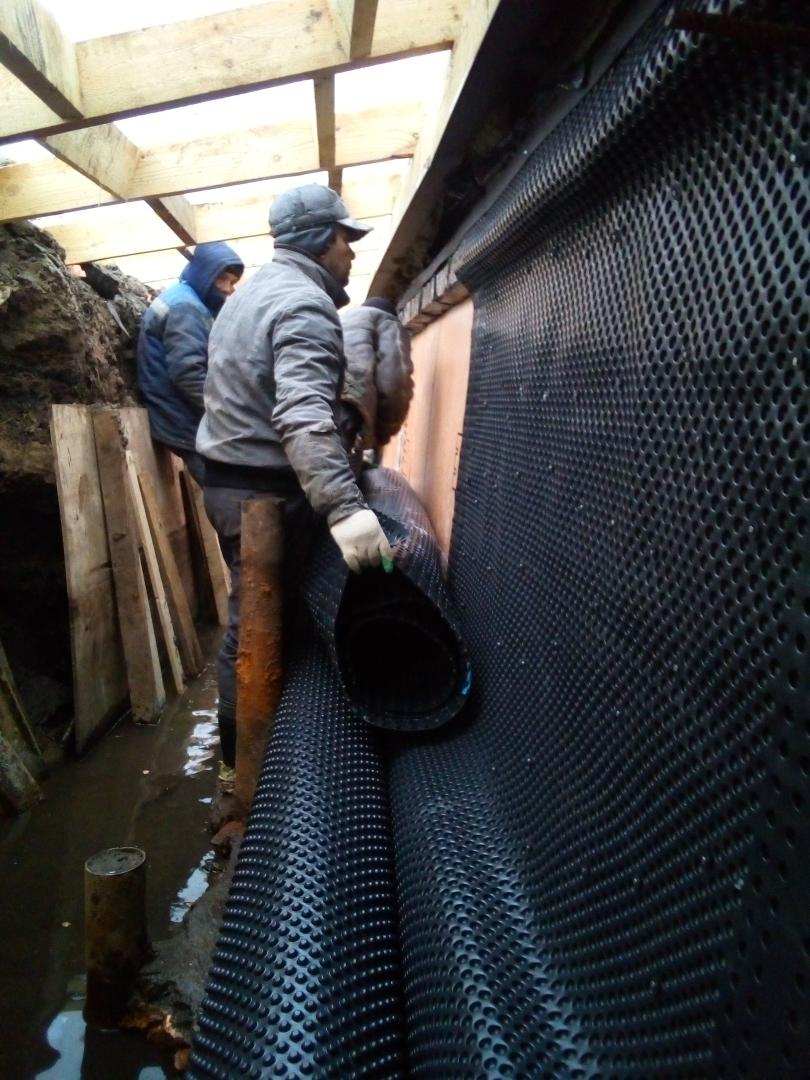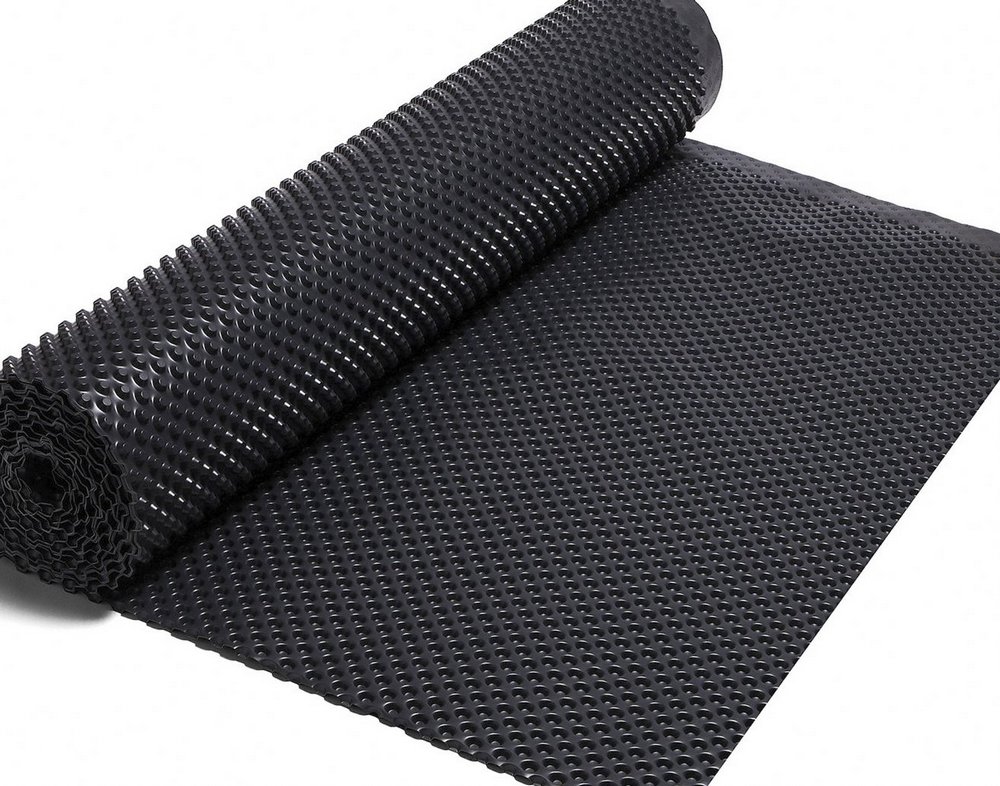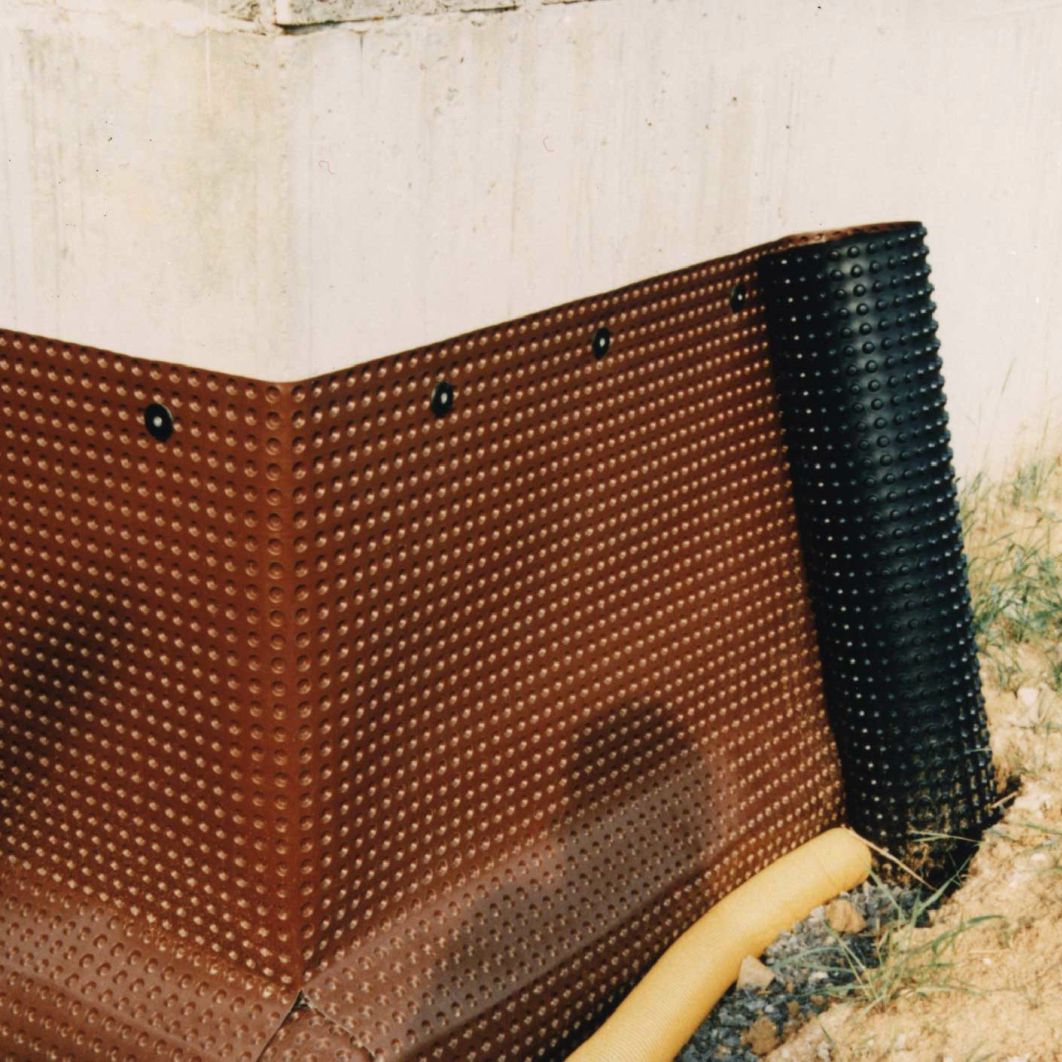Preparation of the foundation for a foundation with PLANTER membrane
- Base soil;
- Sand preparation;
- Polyethylene film;
- Concrete preparation;
- Foundation slab.
The construction of the foundation inevitably requires the preparation of the subgrade. On a site with a low groundwater level, it consists in surface leveling, excavation, preparation of the pit bottom and creation of a capillary cutoff. Since the end of the twentieth century, the classic method of preparing the bottom of the pit has been the preparation of concrete with a thickness of 80 to 100 mm - the so-called "footing". Carry out a "footing" for fusing the gluing waterproofing, as well as to obtain a flat and solid surface before installing the reinforcement. The classic "footing" is a well-known technology, but with low manufacturability.
In the calculations of the bearing capacity of the foundation, the "footing" is not involved. When building a foundation in sandy soils with a low groundwater level, there is no direct need to protect the slab in the form of waterproofing. Thus, it is advisable to abandon the foundation for its fusion.
Laying technology of the profiled membrane Planter standard
What does the modern preparation of the base for a slab foundation look like?
The PLANTER profiled membranes are an excellent alternative to the classic "footing". Preparation of the base for a slab foundation made of membranes has a number of technological and economic advantages.
The technological attractiveness of using membranes as a substitute for a footing lies in the ability of membranes to perform the functions of a footing, namely:
- Obtaining a flat and solid surface suitable for planning works, works on laying reinforcing cage and concrete;
- Providing optimal conditions for concrete hardening (foundation slab) and excluding the migration of mixing water and cement paste from the concrete mixture into the base soil.
Foundation protection membrane Planter
In addition, PLANTER membranes prevent capillary rise of moisture, performing the function of capillary waterproofing under the foundation slab. The technology of using membranes as a substitute for footing has been approved by specialists from the Research Institute of Concrete and Reinforced Concrete (NIIZhB) and tested at many construction sites in Russia and neighboring countries.
How to work with waterproofing membranes
Working with waterproofing membranes
It might be interesting
Installation of waterproofing membrane:
- the working area is carefully cleaned of debris;
- the base is primed;
- mastic is applied to the working area;
- lay the membrane on the working surface. Laying is done with spikes inward. If geofiber reinforcement is prescribed in the project, then the membrane sheet is laid with spikes outward.
- Pieces of membrane film are pressed tightly, adhering to the base, checking the quality of adhesion, fixing with an overlap:
- fix the structure with a special bar;
- from above, the structure is glued with geotextiles, after which channels for water drainage are formed inside. Then it is diverted from the foundation body with the help of drains.
It is possible to strengthen the waterproofing membranes directly on the foundation walls if the building is on sandy or rocky soil. In this case, the ox does not stagnate, flows quickly into the depths and does not touch the foundation.
Types of waterproofing coatings
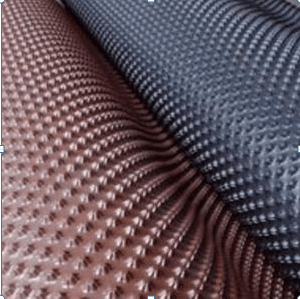 Type of profiled products for waterproofing building foundations
Type of profiled products for waterproofing building foundations
The membrane is already beginning to slowly displace conventional roofing material or coating mastics from the building materials market. It is easy to use, easy to install and does not require seasonal maintenance.
Thanks to its design and good technical characteristics, it perfectly protects the foundation walls from any impact of groundwater, while not deforming over time. The main types of membranes:
- Flat film designs. They are made from polyethylene and other synthetic polymeric materials, and they are often human waste. Thus, film membranes are relatively inexpensive, with an average film thickness of 0.2–2 mm. For waterproofing the bases, films with a thickness of at least 0.4 mm are used. Also on sale there are flat corrugated membranes, they have a high degree of adhesion to the solution.
- Profiled membranes are made only of high pressure polyethylene, have various shapes and are equipped with special protrusions. It can be single-layer or multi-layer, it is used exclusively to protect foundations from ground and rainwater, they can also be used as a drainage system in conjunction with geotextiles. Profiled membranes have a sheet thickness of up to 1 mm, a protrusion height of up to 8 mm (private use), or up to 20 mm (industrial and mine use).
For each manufacturer, the width of the sheets may differ, the sheets are attached directly to the leveled wall or on a concrete mortar, therefore, a waterproofing membrane is at the same time protection against mechanical damage.
 Scheme for cutting and laying the profiled drainage membrane on the foundation.
Scheme for cutting and laying the profiled drainage membrane on the foundation.
Membrane types
 Profiled membrane with snap joint
Profiled membrane with snap joint
There are several varieties of this building material:
- Flat;
- Profiled.
The flat membrane is a film. Its thickness can vary from 0.2 to 2 mm. The place of its application depends on the thickness. The material with a thickness of 0.2 mm is ideal for waterproofing floors, and for foundations, the recommended thickness is more than 0.4 mm. For high-quality adhesion, a special mounting technology is used.
The profiled membrane looks like a corrugated sheet, its thickness is 0.5-1 mm. The height of the protrusions on such a sheet depends on the conditions of use, on average about eight millimeters. The waterproofing of the object depends on the conditions of the external environment, it can be single-layer or multi-layer. The profiled membrane has its own laying technology. It is attached directly to the wall, and performs a waterproofing and protective role.
Application of profiled waterproofing materials
The sheet is laid out with protrusions outward, geotextiles are spread on top of it. As a result, artificial channels are formed between the surfaces, connected to the drainage system of the house. Thus, ground water or condensation formed without interference is removed from the surface of the film, without causing any harm. More expensive membrane models have a combined structure, where it is simultaneously used as an external filler geotextile.
Membranes can also be used as an element of multilayer waterproofing systems. In such cases, it perfectly protects the layer of bitumen mastic or roofing material from mechanical damage, and improves water drainage even during flash floods. But before installing them, you need to make a high-quality drainage system with a water drainage complex.
Waterproofing a wall in the ground
PVC membranes have another distinctive feature. With the use of waterproofing membranes, it is possible to arrange a repairable system in the case of erection of foundations according to the principle of "wall in the ground", i.e. in the case of a membrane located between two layers of concrete.
The essence of a repairable system is dividing the waterproofing membrane with special gaskets into separate cards (approximately 100-150 m2 each) and installing special injection fittings, which allows you to quickly determine the location of damage (leaks), and thereby eliminate individual leaks in a certain card, and not in the entire waterproofing circuit of the structure.
When dividing the membrane into separate cards, it is recommended to use TECHNONICOL PVC side waterstops as special gaskets.The waterstops are welded with hot air using special equipment to the LOGICROOF T-SL membrane mounted on a concrete surface, as a result, all waterproofing is divided into local zones (maps), bounded along the PVC perimeter with a waterstop. The division into maps localizes water leaks within one map and prevents water movement between maps in the event of damage to waterproofing in one of the maps.
Each limited card is installed from 2 to 6 PVC fittings, but not less than 2 pieces, regardless of the size of the local zone (card). The fitting is point-welded to the PVC membrane during the construction of the waterproofing system. A control and injection tube (for example, made of polypropylene) is inserted into the fitting and tightened with a steel clamp. The tubes are installed during the installation of the reinforcement cages and are decoupled from the reinforcement to prevent them from moving during the concreting process. Injection tubes of one localized card are connected in a mounting box, through which injection work is carried out.
If a leak is found in any of the zones, the repair is carried out by pumping in special repair compounds, for example, based on polyurethane, epoxy resins, acrylate, polymer cement, etc. on control and injection tubes.
1 - soil; 2 - pit fence; 3 - leveling layer; 4 - geotextile; 5 - PVC rondel; 6 - waterproofing membrane LOGICBASE V-SL (LOGICROOF T – SL); 7 - waterstop; 8 - injection fitting; 9 - geotextile; 10 - polyethylene film; 11 - withdrawal of injection tubes; 12 - internal supporting structure
In case of unfavorable hydrogeological conditions (presence of high hydrostatic pressure of groundwater), along with a single-layer repair system, it is possible to use a two-layer (active) waterproofing system. A two-layer waterproofing system consists of two layers of PVC membranes and is used to increase the degree of protection of underground structures at high groundwater pressures.
Types and properties of membranes
Membranes for waterproofing are a group of modern materials for insulation of building structures of houses and thermal insulation systems from water. Getting into the inner space of the house, it destroys it, making it unsuitable for a full life.
In construction, a distinction is made between waterproofing films and membranes.
There are no fundamental differences between them. The multilayer and breathable properties claimed for the membranes are in fact an improved property of the same films.
Film furniture is divided into two categories:
- polymer film waterproofing membrane - used in insulation of roofs, plinths and foundations from aggressive moisture from the soil and atmosphere. It is used when the foundation structures lie higher than the groundwater. It is made in the form of a polymer film reinforced with a special thread with an approximate thickness of 0.2 to two millimeters. It is also used for insulation during roofing works.
- profiled film membrane waterproofing - is a multi-layer polyethylene of increased strength with stiffening ribs. It is used in waterproofing works if the occurrence of soil water is higher than the basement floor of the building. Such a membrane retains the water pressure for a long time, provided that the installation work is performed correctly.
Film membranes
Membranes of the first type (film) are used to protect roofs and foundations. The film in such a membrane is reinforced with a reinforcing thread. The holes in the film allow the insulating coating to allow free passage of air, which makes it possible for the surface under the film not to "suffocate" from steam, and moisture does not get inside.
Such a membrane is used to prevent condensation from forming under tiles or profiled decking. The waterproofing vapor-conducting film is much stronger than previously used materials and is not afraid of ultraviolet radiation.
Film membranes are made from:
- modified PVC;
- rubber-propylene mixture:
- synthetic rubbers.
This material is used to isolate the foundation from water. This kind of insulation is called "light".Compared to the old method of insulation with roofing felt or bitumen, it is extremely simple - the film is laid on the surface to be insulated, heated.
The film lies on the surface without gaps. In the process, no joints are formed that need to be further processed. The shelter formed by the use of waterproofing membranes can last up to fifty years.
If it is necessary for various reasons to connect parts of the membrane membrane, it is necessary to use the appropriate glue, special adhesive waterproofing tape, or apply the edge welding method.
PVC membranes
Membrane type
Construction work carried out using the material - polyvinyl chloride membrane for waterproofing, will be much cheaper than those carried out using bitumen, roofing felt or other traditional materials due to the lower cost of the film used and the cost of paying the masters.
- Rubber membranes are quite expensive, but their properties are better than traditional ones.
- Waterproofing polymeric membranes do not lend themselves to the action of acidic substances and environments, they are resistant to damage and rupture, they are difficult to tear, cut or puncture. Resistant to sufficiently high or very low temperatures.
- Profiled membrane film is a material for "heavy" waterproofing. For production use durable polyethylene in one or several layers. On the surface of the film there are stiffening ribs (protrusions-spikes up to 20 mm).
The industry produces film in the form of various sheet widths ranging from 1 to 2.5 meters. The film thickness reaches one and a half millimeters. Its use is justified when working on waterproofing foundations in buildings, the level of which is below the level of groundwater. With their help, moisture is cut off in the right direction from the foundation walls and underground utilities.
Such membrane waterproofing of the foundation with the help of a profiled film allows you to cut off the aggressive effects of acids, mold, since the material does not lend itself to their influence. Spiking makes it possible to create a dry air layer above the surface of the foundation wall, while water does not get under the film. Waterproofing membranes are lightweight, which allows them to cover all types of surfaces.
There are several techniques for attaching films:
- gluing with floor adhesive;
- dowel fasteners with sealed washers.
Fastening waterproofing membranes
-
Membrane assembly
To simplify fastening, self-adhesive membranes are produced, on one side of which an adhesive base is applied. It is protected from drying out by paper. During installation, the paper is removed, the PVC film is bonded to the surface and leveled with a roller. It fits with an overlap, without elements of an additional connection.
- The surface to be covered with a flat PVC membrane must be leveled, well cleaned and, most importantly, dry. For tightness of insulation, its sheets are laid with an overlap, which should be at least five centimeters. The seam is coated with glue, or glued with special adhesive tapes, or welded with hot air.
- The fastening of a spiked (profiled) waterproofing membrane is divided into three stages:
- The membrane is fixed in the upper part of the foundation by means of profiled strips, which press it against the foundation and allow, if necessary, to remove moisture from them.
- Along the edges of such membranes there are special latches that serve as their connection. If they are not there, then laminated adhesive strips on a paper basis are used, which is removed when gluing.
- The membrane is attached to the lower part of the base of the foundation using dowels with profiled washers, which ensure tightness at the attachment point.
Currently, the use of a profile membrane when performing foundation waterproofing is becoming a common solution. Its protection of structures located in the underground part of the building from water, groundwater pressure and drainage function is very effective. Watch the video on how to install a waterproofing membrane.
By their structure, waterproofing systems based on corrugated membranes are divided into:
- Single layer. Profiles or spikes are located along the entire membrane surface. It is used for waterproofing and ventilation of foundation surfaces.
- Two-layer. To create it, a layer of geotextile cloth has been added. It performs the functions of waterproofing and drainage.
- Three-layer. Added another layer of PVC sliding film. Its purpose is to prevent the resulting loads on the foundation during heaving movements of the soil.
One of the significant quality indicators of the membrane is its thickness, depending on which the physical indicators are tensile strength, resistance to damage from mechanical stress.
The use of profiled membranes is universal. With different installation methods, they perform different functions.
- If the membrane is placed with spikes against the wall, then the air gap formed by them promotes ventilation, which ensures a favorable temperature regime.
- The uniform arrangement of the spikes (cells) on the surface of the membrane performs an orderly distribution of the pressure of the soil layers on the surface of the foundation. Neutralizes the occurrence of point loads.
- When the membrane is laid with spikes to the ground and in combination with a geotextile sheet, vertical drainage is obtained, which removes water and reduces the water level in the soil.
Polymer membranes have a number of advantages:
- They do not adhere tightly to the foundation, which protects them from heaving of soils.
- They do not need special leveling of the base.
- They have the lowest water absorption.
- Resistant to aging.
- Not subject to decay.
Climatic (weather) conditions
When working with rolled PVC materials, the ambient temperature should not be lower than minus 15 ° С.
When performing work at temperatures below + 5 ° C, it is necessary to keep the rolls in a warm room at a temperature not lower than +15 C for a period of at least 12 hours.
Installation of a waterproofing membrane made of rolled PVC materials is not allowed on wet bases (with standing water), as well as during fog, precipitation and if there is frost or frost on the surface of the building structure. In such weather conditions, the substrate must be dried, for example using propane burners.
If it is necessary to carry out installation work in adverse weather conditions, it is necessary to use special greenhouses, awnings, awnings, etc., which provide the required conditions for installation.
Video description
The installation process of the waterproofing membrane is demonstrated in this video:
Waterproofing membrane membrane
The technology is similar to the installation of roll-on classical insulation, but much simpler:
- At the bottom of the base, PVC rondels are installed with a step of no more than 1.5 m for fastening the material. The film should protrude 30-40 cm above ground level and cover part of the base.
- The sheets are cut taking into account the overlap below the base of the foundation of 20-30 cm. When filling the sinuses, make sure that stones or sharp objects do not damage the insulation.
- The film is spot-welded to the fastener.
- The sheets are overlapped, connected with tape, special glue, welding, a construction hairdryer or on self-adhesive strips.
- After filling the sinuses of the foundation, the film on the plinth is covered with protective plaster or decorative panels.

Waterproofing membrane membrane
Vertical insulation with profile membrane
The convenience of laying the profile material is that the surface does not need to be primed, glue applied or burners with an open flame are used. Drainage is preliminarily laid under the sole of the foundation.
Sequence of work:
- Install profile strips along the top of the foundation.
- Fix the membrane to them with spikes inward, unless otherwise specified in the instructions.
- The sheets are overlapped, fixed with locks.
- In the lower part, the film is fixed with dowels with profiled washers, ensuring tightness.
- From above, the structure is pasted over with filtering geotextiles.

Vertical waterproofing
Horizontal insulation of foundations with a profile membrane
Waterproofing works are carried out at the stage of foundation construction.
Membrane insulation of foundations for shallow slab foundations is carried out using the following technology:
- The pit is torn off to a depth of 40-50 cm.
- Drainage is prepared.
- The soil is compacted and leveled.
- Insulate the base with polystyrene foam plates.
- A migration separating layer of geotextile with a density of 110 g / m³ is laid in order to exclude contact of the heat insulator with the membrane, leading to a gradual loss of elasticity of the film.
- The panels are mounted with an overlap of at least 50 mm.
- The edges are thoroughly cleaned.
- The edges are connected by welding or a construction hairdryer.
- Geotextiles with a density of 500 g / m³ are laid to protect the membrane from mechanical damage during the installation of formwork, reinforcement and concrete pouring.
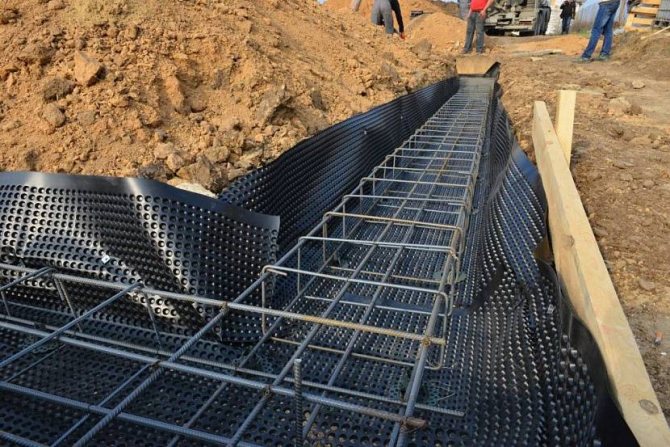
Horizontal waterproofing After welding or gluing the edges, the quality of the seam is checked. To do this, cut a strip 15 cm long and 5 cm wide across the joint, test for rupture. Destruction must occur along the material, not along the seam. The incision site is closed with a film patch.
Where membranes are used
Contact with water is dangerous for most types of building materials, including widely used concrete. The liquid falling on the surface penetrates into the pores, washes out the components of the cement binder, and accelerates the corrosion of the reinforcement.
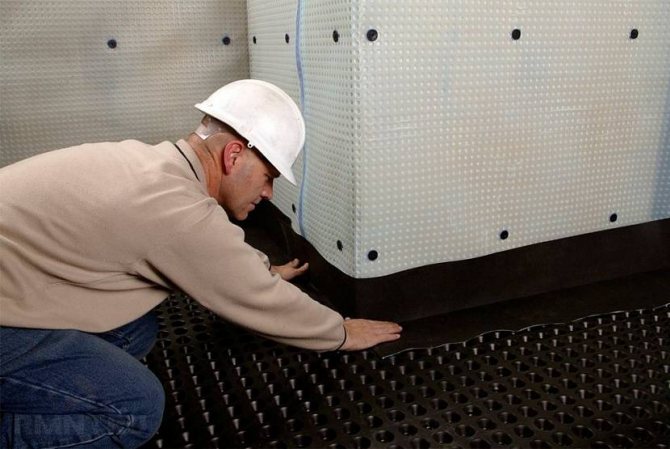
Basement membrane waterproofing Source.
Through filtration, the walls resting on the foundation are saturated with water. As a rule, they are built from porous materials with low thermal conductivity. An increase in humidity significantly reduces their thermal insulation properties, contributes to the appearance of mold on the surface, worsens the microclimate in the room.
Constant dampness changes the properties of materials, reduces load-bearing capacity, causes rapid destruction of structures and a reduction in service life.
Waterproofing with membrane films is used to protect:
- foundations on wet soils, heaving soils with high GWL;
- underground structures - basements, tunnels, parking lots, elevator shafts, bridge supports, viaducts;
- flat or pitched roofs, balconies;
- reservoirs - pools, wells, ponds;
- walls and floors of rooms with high humidity - showers, toilets, baths.
Manufacturers of waterproofing films guarantee their reliable operation for 25-30 years. Leading Russian manufacturers of polymer membranes for foundations - Tema, Renolit, Ikopal, Penoplex, Sika, Protan. Bituminous ones are produced by the concerns "Bikrost", "Rubiteks", "Izol".
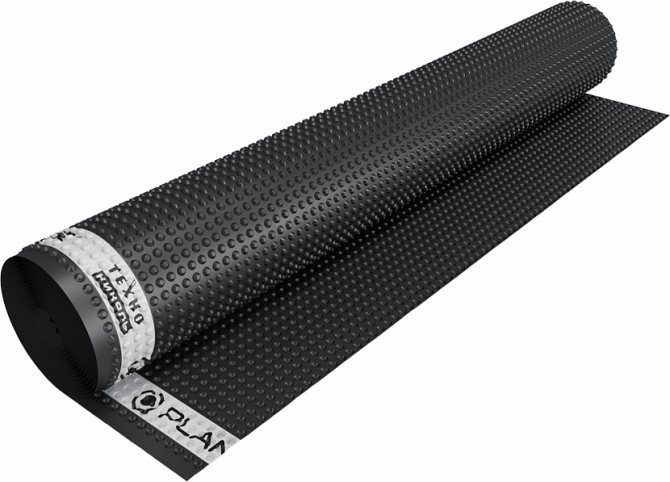
Membrane "Technonikol" Source.
The cost of membrane coatings ranges from 85 to 1100 rubles per square meter.
Membrane film marking
Provided the correct mounting (with ventilation gap) is very effective.
Waterproofing membranes are a modern, lightweight, easy-to-use building material. Its use makes it pleasant and quick to work on waterproofing foundations and plinths of buildings, allows you to reliably carry out roofing work, and allows you to build "heavy" waterproofing quickly, easily, efficiently.
The ratio of price and quality of work performed with the help of waterproofing membranes makes it possible for this building material to compete with traditional proven materials.
Polymer membrane waterproofing
Outside the domestic market, film materials began to be used in the mid-60s, which gave impetus to their widespread use in waterproofing roofs. The introduction of the latest technologies and the improvement of materials allowed us to give them fundamentally new properties. The multilayer structure, perforation and reinforcement with a mesh of synthetic threads allowed them to be used as membrane waterproofing, providing reliable protection of vertical and horizontal surfaces.
Depending on the materials used in the manufacture, the polymer film membrane is represented by three main types:
- PVC membrane - based on plasticized polyvinyl chloride;
- TPO membrane - based on thermoplastic polyophenes;
- EPDM membrane - based on polymerized ethylene propylene diene monomer. It is also called synthetic rubber.
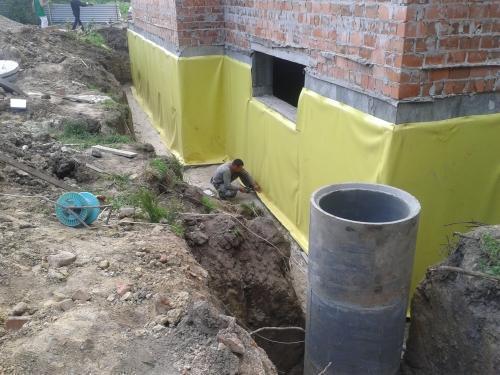
Due to its low specific gravity, the film membrane does not create such an additional load on the foundation as two-layer polymer-bitumen coatings. The large width of the rolls allows you to achieve a minimum number of seams on the insulated surface.
Features of PVC membrane
The PVC film membrane is by far the most demanded material, as well as a budget solution for providing waterproofing of foundations. The material is an unreinforced two-layer polyvinyl chloride cloth, the upper layer of which consists of chalk, plasticizers and anti-foam, and the lower one is made of pure PVC with the addition of coloring pigments. This composition of the membrane provides high resistance to salt solutions in soils and suppresses the combustion of the polymer base. The material has elasticity, which makes it possible to work with it at low temperatures.
Film membranes are available in different thicknesses, which makes it possible to use them more efficiently. The choice of material, in this case, is influenced by the depth of the foundation.
Installation of waterproofing can be carried out on an unprepared surface, but it is worth remembering that direct contact with phenol-containing foams, bitumen-based materials or expanded polystyrene leads to a violation of the integrity of the film coating. The use of a backing layer made of thermally bonded geotextiles helps to avoid negative consequences, which prevents the consequences of direct contact.
One of the main advantages of PVC membranes is the ease of joining fabrics, produced by hot air using a hot air gun or a special welding machine. This technology provides sufficient strength and tightness of overlapped seams, forming, in fact, a seamless, integral coating.
Among the disadvantages of PVC membranes, one can note its high susceptibility to mechanical damage, as well as the insufficient ecological purity of the material, which contains volatile substances in the form of various plasticizers.

Features of TPO membrane
The two-layer material is created on the basis of a polymer mixture of ethylene-propylene rubber and polypropylene. It simultaneously possesses the properties of rubber and plastic. The introduction of various additives provides the material with hydrophobic and fire-fighting properties, and increases its durability. Due to the reinforcing mesh of synthetic fibers forming the second layer, the membrane gains a higher strength.
The main advantages of the material are high elasticity and environmental friendliness. It has found its application in the waterproofing of swimming pools, artificial reservoirs and volumetric containers for drinking water.Due to the relatively high price, today TPO membrane films are in little demand in the field of foundation waterproofing.
Features of EPDM membranes
Unsurpassed physical and mechanical properties, consisting in the highest elasticity, which allows it to withstand movements of various types, in flexibility at extremely low negative temperatures and in resistance to their high positive values, gives the EPDM membrane a synthetic rubber base. The strength of the polymer waterproofing material is provided by a reinforcing polyester mesh.
The most important advantage of EPDM membranes is its compatibility with various bituminous materials, as well as environmental friendliness. A significant disadvantage is the adhesive component in the connection of polymer film canvases.
The seam obtained in this case does not have sufficient reliability in comparison with the welded analogue.
Correct installation of the waterproofing membrane
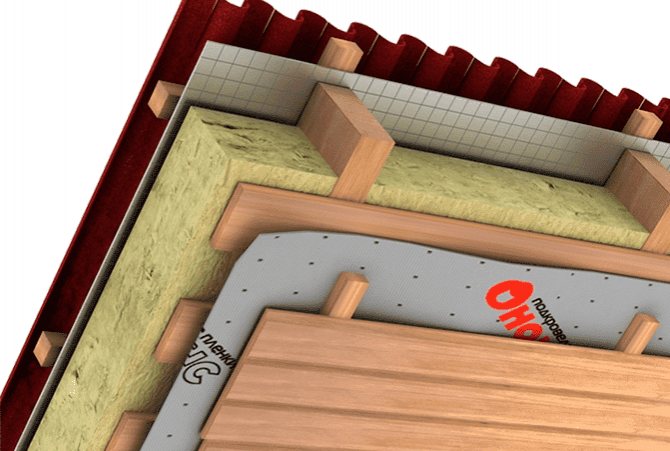
The installation method of waterproofing membranes differs depending on whether it is installed on the roof or on the walls. But the general steps for laying waterproofing membranes are as follows:
- The waterproofing membrane is always laid on the insulation, which is pre-installed on the roof and walls.
- The membrane is cut into pieces of the required length and spread on the surface.
- Installation of the membrane is carried out from bottom to top with horizontal panels of the required length.
- A construction stapler can be used for fixing to wooden elements.
- Subsequent layers of the membrane are applied with a mandatory overlap of about 10 cm.
- For reliable protection of joints, a special mounting tape is used.
- The next step is to fix the membrane with wooden beams and install the outer cladding for the walls or roofing materials for the roof.
Installation of a waterproofing membrane is a simple process that does not require special skills. Read more in the article "Installation of a waterproofing film" and watch video clips.
Features of waterproofing membranes
Membrane waterproofing materials have some advantages over pasting and coating. Often they are used in combination to achieve durable and reliable moisture protection. The membrane itself is a high-strength thin roll material. It is very elastic, due to which it does not burst and does not crack during shrinkage of buildings, it can withstand serious mechanical stress.
 Installation of membrane waterproofing
Installation of membrane waterproofing
The scope of application of membrane waterproofers is extensive. They are used to protect roofs, walls, facades, foundations, basements, underground building structures. Depending on the purpose, the properties of materials differ, but they are all suitable for installation in almost any conditions. This compares favorably with many other insulators that have limitations on the range of operating temperatures or the degree of humidity of the bases.
 Membrane waterproofing device diagram
Membrane waterproofing device diagram
Depending on the structure, all membrane waterproofers can be conditionally combined into two large groups:
Flat polymer. The material is made of polyvinyl chloride, consists of several layers welded together. The bonding technology is such that the layers are linked at the molecular level. The surface of the polymer membrane is an integral homogeneous structure. The insulator is strong, elastic, durable and reliable.
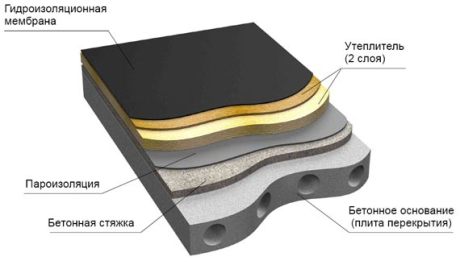 Installation diagram of a flat polymer membrane
Installation diagram of a flat polymer membrane
Profiled. For the manufacture of profiled membranes, high-strength HPDE polyethylene is used. The surface is not smooth, dotted with projections resembling rounded spikes, the sizes of which can vary from 7 to 20 mm. Their height depends on the type and brand of the insulator. The material can consist of one, two, three or even four layers.
When installing the membrane, an air layer is formed, which provides complete drainage of the foundation and ventilation. The material can be attached directly to the walls. It serves as a reliable waterproofing agent and protection against mechanical stress.
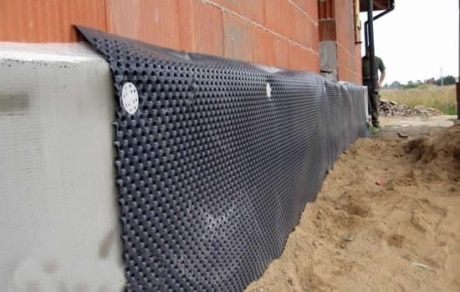 Profiled membrane
Profiled membrane
Membrane waterproofers vary in thickness and structure. The choice should be based on the type of surface to be protected. Moisture insulation can be easy when it comes to houses on permeable soils. In this case, insulating materials are chosen that protect against capillary suction and atmospheric water.
Medium or heavy waterproofing is needed when there is a high level of groundwater, especially if it rises to the level of the foundation, basement and / or floor. Serious protective measures are also needed if the basement floods during floods. The foundations of buildings on poorly permeable soils are protected with drainage membranes, they help to avoid the effects of moisture accumulating near the walls of houses.
 Schematic: drainage membranes
Schematic: drainage membranes
Installation of waterproofing membrane
Carrying out protective work using a waterproofing membrane is carried out in a certain order in compliance with the basic rules:
Preparatory work
The surface of the foundation to be waterproofed is cleaned of debris and dirt. Traces of mold and mildew must be removed from it. The foundation is examined for cracks, which are sealed with a cement mortar. The existing protrusions are eliminated so as not to damage the membrane during installation and during backfilling of the foundation. The prepared surface is covered with a layer of primer.
Also, at the preparatory stage, the amount of material required is calculated, the direction of the canvases and the places of their connection are determined. To protect the waterproofing membrane from the negative effects of bitumen and other polymers, a backing layer is used, for example, geotextiles.
Membrane mounting technology
Waterproofing a foundation with a membrane can be done in two ways:
- Horizontal styling. In this case, at first, the prepared base is covered with geotextile with an overlay of the free edge of the web of at least 15 cm. A construction hairdryer is used to weld the joints. The membrane is laid on top of the backing layer. In areas where the horizontal surface turns into a vertical plane, an additional strip of protection is installed. Its width must be at least 1 meter. For horizontal waterproofing, it is recommended to use flat membrane membranes.
- Vertical waterproofing of the foundation is carried out using profiled membranes. Using this method of waterproofing the base requires additional steps. Special elements are mechanically attached to the base - plastic rondels. Their installation is carried out in increments of 1 meter horizontally and 2 meters vertically. The membrane is attached to the rondels by spot welding. The laid membrane for waterproofing the foundation is covered with a protective layer of geotextile. To weld its seams, you will need a building hair dryer. The web is fastened pointwise using polyurethane glue.
Features of membrane welding
The quality of installation work associated with the device on the foundation of waterproofing protection depends on the process of welding the material
It is very important that such work is carried out in stages:
- cleaning the place for the connection;
- test welding;
- checking the quality of the connection after one hour;
- if the test seam complies with the current regulations, the main work can be carried out.
You need to know that the membrane is welded at an air temperature of at least fifteen degrees Celsius. If the work is carried out at low negative temperatures, the waterproofing membrane material will have to be preheated.


